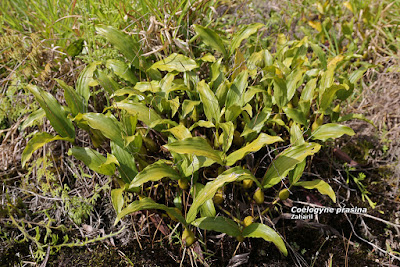Coelogyne prasina is found in Malaysia and on the islands of Sulawesi, Moluccas and Borneo. It grows epiphytic on trees or just on land in hill forests or on mossy clumps in heath forests at an altitude of 1000 to 1500 meters above sea level...
Coelogyne prasina also called as The Leek Green Coelogyne, Coelogyne modesta, Coelogyne rhizomatosa, Coelogyne rhizomatosa var. quinquelobata, Coelogyne vagans, is a species of the genus Coelogyne. This species was described by Henry Nicholas Ridley in 1896.
IDENTIFY COELOGYNE PRASINA ORCHID PLANT
Coelogyne prasina is found in Malaysia and on the islands of Sulawesi, Moluccas and Borneo. It grows epiphytic on trees or just on land in hill forests or on mossy clumps in heath forests at an altitude of 1000 to 1500 meters above sea level.
It is a medium sized, cool growing terrestrial orchid with a long creeping to scrambling rhizome, giving rise every 2 to 15 cm, to a cylindric, tapering towards the apex, yellow, 10 cm long pseudobulb carrying 2 apical, plicate, 7 nerved, narrowly elliptical, gradually narrowing below into the grooved petiolate base, 10-30 cm long and 2-4 cm wide leaves.
The Leek Green Coelogyne blooms in the summer on a terminal, erect, fractiflex rachis, 10 to 20 cm long, few to several flowered, racemose inflorescence that is initially synanthous and sometimes becoming heteroanthus by blooming, has deciduous floral bracts and carrying successive opening flowers that arise out of a new pseudobulb growth. The flowers have a dry scales, pale olive-colored, unfold one after the other as they fade, sometimes in pairs, about 2-3 cm in diameter. Tepals lanceolate with pointed tips, 1.4 cm long and 0.2 cm wide. The lip is triple, its lateral parts are straight, and the anterior round, with denticles, has 2 growths.
COELOGYNE PRASINA ORCHID PLANT CARE AND CULTURE
Cultural information should only be used as a guide, and should be to be adapted to suit you. Your physical location; where you grow your plants, how much time you have to devote to their care, and many other factors, will need to be taken into account. Only then can you decide on the cultural methods that best suit you and your plants.
Light:
Coelogyne prasina loves the bright sun without access to direct sunlight, so during the hot midday sun on the windows of the southern orientation and the hot evening sun on the western windows, the orchid should be placed behind a curtain (for example, on a table near the window) or into the shade of other plants, otherwise, the plant can get a sunburn.
Temperature:
This type of orchid belongs to a moderate temperature regime, and it is recommended to keep the orchids under the following conditions throughout the year: Day temperature at 18-24 ° C; Night temperature not less than 12 ° C. To successfully grow at home, it is necessary that the night temperature of the content is always 4-6 ° C lower than the daytime temperature.
Humidity:
The Leek Green Coelogyne needs the humidity level of 55 to 70%. Too dry air negatively affects the development of the plant and its growth is inhibited.
Substrate, growing media and repotting:
Coelogyne prasina is usually grow in pendant pots or wooden trellised baskets. As a substrate, it is recommended to use a mixture of bark of coniferous trees with moss sphagnum and charcoal. When choosing a pot or basket to plant, you need to take into account that the rhizome of the plant is very long and the pseudobulbs grow far enough from each other, so the pot must be not deep, but large.
At the transplant, this species reacts negatively, so it is recommended to transplant only in cases of severe salinization or compaction of the substrate, its critically low or high pH, or if the plant grows very large and the pot becomes too small. The best time for transplant is the period immediately after flowering.
Watering:
Watering this kind of orchids directly depends on the temperature of the content, the higher it is, the more often and abundant it is necessary to water. When watering orchids in pots, it is necessary to remember that excess water during watering should flow freely out of the pot, as the stagnation of water both inside the pot and in its pallet can very quickly lead to rotting of the roots and the lower part of the plant. The substrate between the irrigations should dry relatively well, but do not dry completely.
Fertilizer:
During the new growth period, this type of orchid is fertilized for every third watering in 1/2 or 1/4 of the fertilizer concentration indicated on the package. In addition to the usual root top dressing, it is also recommended to produce a foliar dressing, when a very much diluted fertilizer is sprayed on the outer part of the plant. It is best to feed the orchid, alternating both these methods. During the whole year (especially at the beginning of the growing season) it is recommended to use a balanced fertilizer with the same proportion of nitrogen, phosphorus and potassium, for example, NPK = 3-3-3 or 8-8-8. To prevent salinization of the substrate in the intervals between top dressings, a good washing is necessary. To do this, the orchid should be placed under a stream of warm water and several times well shed.
Rest period:
Coelogyne prasina does not need a rest period. Refusal of flowering can be caused by the stressful state of the plant with too hot content and the absence of colder night temperatures. The ideal temperature of the content at the time of the formation of new germs 18-20 ° C in the daytime and 14-16 ° C at night.















COMMENTS